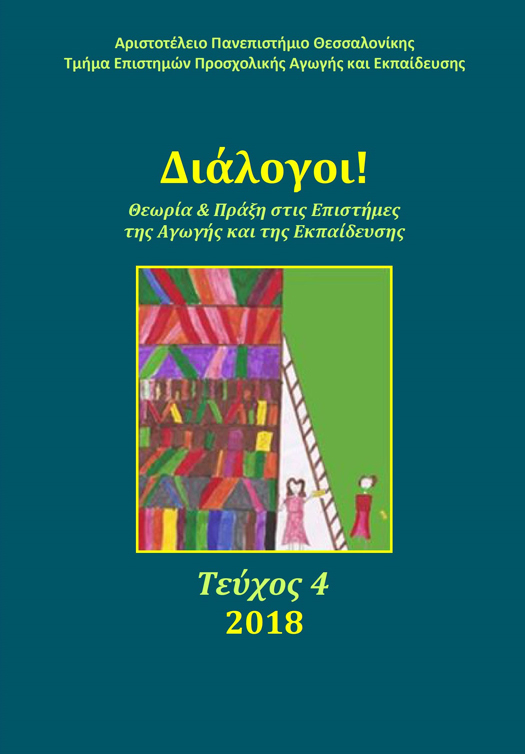Κινητική ανάπτυξη μέσα από ένα διαθεματικό πρόγραμμα φυσικής αγωγής και παιδικής λογοτεχνίας στο νηπιαγωγείο

Περίληψη
Σκοπός της έρευνας είναι η αξιολόγηση της επίδρασης ενός διαθεματικού προγράμματος Φυσικής Αγωγής (ΦΑ) μέσω της παιδικής λογοτεχνίας σε παιδιά προσχολικής ηλικίας. Η προσέγγιση αυτή στοχεύει στην ανάπτυξη βασικών κινητικών δεξιοτήτων μέσα από αφήγηση επιλεγμένων λογοτεχνικών κειμένων, ως ερεθισμάτων κινητικής εξερεύνησης, έκφρασης και επικοινωνίας. Στην έρευνα έλαβαν μέρος 50 νήπια (29 αγόρια και 21 κορίτσια) χωρισμένα τυχαία σε τρεις ομάδες, μία ομάδα παρέμβασης και δύο ομάδες ελέγχου. Η ομάδα παρέμβασης περιελάμβανε 18 νήπια Μ.Ο.: 70.7 , η α’ ομάδα ελέγχου 16 νήπια Μ.Ο.:69.8 και η β’ ομάδα ελέγχου 16 νήπια Μ.Ο.:60.8. Το παρεμβατικό πρόγραμμα εφαρμόσθηκε στην ΟΠ, διήρκησε 2 μήνες με συχνότητα 2 φορές την εβδομάδα και περιελάμβανε 16 σαρανταπεντάλεπτες οργανωμένες δραστηριότητες. Η α΄ΟΕ παρακολούθησε 16 σαρανταπεντάλεπτες οργανωμένες δραστηριότητες ΦΑ, σύμφωνες με το αναλυτικό πρόγραμμα, ενώ η β’ ΟΕ δεν παρακολούθησε συγκεκριμένο πρόγραμμα, ενώ ασχολήθηκε με ελεύθερο κινητικό παιχνίδι αντίστοιχου χρόνου. Για την αξιολόγηση της κινητικής απόδοσης των παιδιών χρησιμοποιήθηκε, πριν και μετά την παρέμβαση η δέσμη Karlsruher Motorik – Screening 4 – 6 (Bös, Bappert, Tittlbach, & Woll, 2004). Η ανάλυση των αποτελεσμάτων ανέδειξε τη βελτίωση της ΟΠ και της α΄ ΟΕ σε τρεις από τις τέσσερις μεταβλητές και της β΄ ΟΕ σε μία, αλλά η ΟΠ υπερείχε στατιστικά σημαντικά σε δύο μεταβλητές (στο άλμα χωρίς φόρα και στη δίπλωση κορμού) συγκριτικά, τόσο με την α΄ ΟΕ, όσο και με την β΄ ΟΕ. Συμπερασματικά, η βελτίωση των κινητικών δεξιοτήτων ήταν συνολικά μεγαλύτερη στην ΠΟ σε σύγκριση με τις δύο ΟΕ και το διαθεματικό πρόγραμμα αξιολογείται θετικά.
Λεπτομέρειες άρθρου
- Πώς να δημιουργήσετε Αναφορές
-
Παυλίδου Ε., Χατζηγεωργιάδου Σ., & Γκαλκανοπούλου Ο. (2018). Κινητική ανάπτυξη μέσα από ένα διαθεματικό πρόγραμμα φυσικής αγωγής και παιδικής λογοτεχνίας στο νηπιαγωγείο. Διάλογοι! Θεωρία και πράξη στις επιστήμες αγωγής και εκπαίδευσης, 4, 39–61. https://doi.org/10.12681/dial.15821
- Τεύχος
- Τόμ. 4 (2018)
- Ενότητα
- Επιστημονική Αρθογραφία

Αυτή η εργασία είναι αδειοδοτημένη υπό το CC Αναφορά Δημιουργού – Μη Εμπορική Χρήση – Παρόμοια Διανομή 4.0.
Οι συγγραφείς των άρθρων που δημοσιεύονται στο Διάλογοι! Θεωρία και Πράξη στις Επιστήμες Αγωγής και Εκπαίδευσης διατηρούν τα δικαιώματα πνευματικής ιδιοκτησίας επί των άρθρων τους, δίνοντας στο περιοδικό το δικαίωμα της πρώτης δημοσίευσης. Άρθρα που δημοσιεύονται στο Διάλογοι! Θεωρία και Πράξη στις Επιστήμες της Αγωγής και Εκπαίδευσης διατίθενται με άδεια Creative Commons 4.0 και σύμφωνα με την άδεια μπορούν να χρησιμοποιούνται ελεύθερα, με αναφορά στον/στη συγγραφέα και στην πρώτη δημοσίευση για μη κερδοσκοπικούς σκοπούς και με δικαίωμα τροποποίησης μόνον με παρόμοια διανομή (αν αναμείξετε, τροποποιήσετε, ή δημιουργήσετε πάνω στο υλικό, πρέπει να διανείμετε τις δικές σας συνεισφορές υπό την ίδια άδεια όπως και το πρωτότυπο).
To Τμήμα Επιστημών Προσχολικής Αγωγής και Εκπαίδευσης του Αριστοτέλειου Πανεπιστημίου Θεσσαλονίκης και το Εθνικό Κέντρο Τεκμηρίωσης διατηρούν το δικαίωμα να δημοσιεύουν, να αναπαραγάγουν, να παρουσιάζουν στο κοινό, να διανέμουν και να χρησιμοποιούν άρθρα που δημοσιεύονται στο Διάλογοι! Θεωρία και Πράξη στις Επιστήμες Αγωγής και Εκπαίδευσης σε οποιοδήποτε μέσο και μορφή είτε μεμονωμένα είτε ως μέρη συλλογικών έργων, για όλο το χρόνο διάρκειας προστασίας της πνευματικής ιδιοκτησίας και για όλες τις χώρες του κόσμου.
Αυτό περιλαμβάνει ενδεικτικά, και όχι αποκλειστικά, το δικαίωμα δημοσίευσης των άρθρων σε τεύχη του περιοδικού Διάλογοι! Θεωρία και Πράξη στις Επιστήμες Αγωγής και Εκπαίδευσης, αναπαραγωγής και διανομής μεμονωμένων αντιγράφων των άρθρων, αναπαραγωγής ολόκληρων των άρθρων σε άλλη έκδοση του Τμήματος Επιστημών Προσχολικής Αγωγής και Εκπαίδευσης του Αριστοτέλειου Πανεπιστημίου Θεσσαλονίκης και του Εθνικού Κέντρου Τεκμηρίωσης και αναπαραγωγής και διανομής των άρθρων ή περίληψης αυτών με χρήση πληροφορικού συστήματος αποθετηρίου.


